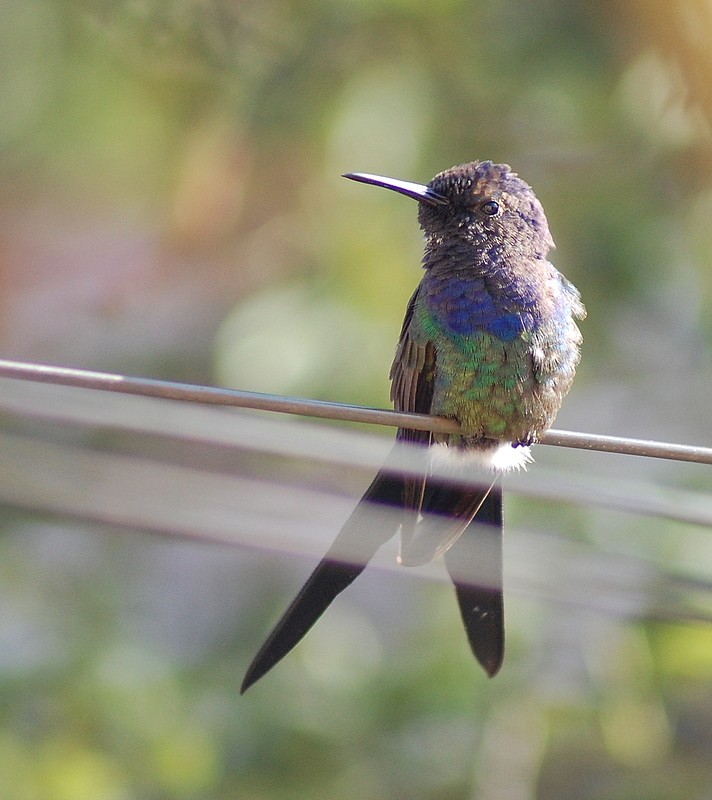Swallow-tailed Hummingbird
A species of Swallow-tailed Hummingbird Scientific name : Eupetomena macroura Genus : Swallow-tailed Hummingbird
Swallow-tailed Hummingbird, A species of Swallow-tailed Hummingbird
Botanical name: Eupetomena macroura
Genus: Swallow-tailed Hummingbird
Content
Description General Info
 Photo By Dario Sanches , used under CC-BY-SA-2.0 /Cropped and compressed from original
Photo By Dario Sanches , used under CC-BY-SA-2.0 /Cropped and compressed from original Description
With a total length of 15–17 cm (6–6 ⁄2 in), nearly half of which is made up by the tail, and weighing up to 9 g (0.32 oz), this is a relatively large hummingbird. Indeed, in much of its range it is the largest species of typical hummingbird. Its wings are also nearly 8 cm long – quite much for its size by hummingbird standards – though its bill is only of mediocre length, with c. 21 mm (0.83 in) not longer in absolute terms than that of many smaller relatives. Its plumage is brilliant iridescent green, with a blue head, upper chest, tail and vent. The tiny white spot behind the eye, common among hummingbirds, is often not visible in this species, but the white ankle tufts, also common among the Trochilinae, are well-developed. The remiges are blackish-brown. It has a slightly decurved medium-long black bill. The sexes are very similar, but females are about one-fourth smaller and slightly duller than males on average. Immature birds appear like females, but their heads are particularly dull and brownish-tinged. Its voice includes relatively loud psek notes and weaker twitters. A tik call is given when excited or alarmed.It is virtually unmistakable, although occasionally confused with the male violet-capped woodnymph (Thalurania glaucopis). These have only a blue cap however, the remainder of their head is the same green as the belly. 
Size
17 cm
Nest Placement
Tree
Feeding Habits
Swallow-tailed Hummingbird's diet consists mainly of nectar from diverse flowering plants, plus insects caught mid-flight. Aggressive in defending nectar sources, this dominant hummingbird species also consumes epiphytes and bromeliads. They are generalists, exploiting various plant families and displaying aerial hunting prowess.
Habitat
The swallow-tailed Hummingbird thrives in a variety of habitats, including open savannas peppered with shrubs and trees, distinct regions with rocky grasslands, and arid scrublands. Additionally, these birds adapt well to anthropogenic environments such as gardens, parks, and agricultural plantations. They are also prevalent in dense primary forests and along the peripheries of these woodlands.
Dite type
Nectivorous
General Info
Feeding Habits
Bird food type
Distribution Area
The majority of the range of the swallow-tailed hummingbird is in the Caatinga and Cerrado of Brazil, and adjacent parts of northern and eastern Bolivia, and far northern Paraguay. In the coastal regions, it occurs from French Guiana in north to Santa Catarina, Brazil, in south. It generally avoids the rainforest found throughout most of the Amazon Basin, and only extends locally into this region along the southern and eastern edge, in the relatively open habitats along the lowermost sections of the Amazon River, including Marajó Island, and upstream to around the Tapajós River, and in isolated enclaves of woodland or savanna-like habitats within the Amazon (including so-called "Amazonian Caatinga") in south-eastern Peru (upper Urubamba River and Pampas del Heath), southern Suriname (Sipaliwini savanna), central Brazil, and northern Bolivia. It occurs in virtually any semi-open habitat; even gardens and parks within major cities such as Rio de Janeiro and São Paulo. It avoids the interior of humid forest, but does occur in openings or along the edge; the swallow-tailed hummingbird is most common among savanna-like vegetation. It is generally a species of lowlands, but occurs locally up to 1,500 m (4,900 ft). Not a true migrant, some populations move north or south a short distance in the dry winter months. Throughout the bulk of its range, it is among the commonest species of hummingbird, although it generally is uncommon in the outlying regions, particularly where it becomes more humid. In southern Brazil, it is apparently increasing and seems to have extended its range in recent decades. It is considered to be a Species of Least Concern by the IUCN. It was frequently exported for the cage bird trade up to 1970, but like other hummingbirds, it is nowadays on CITES Appendix II and trade is restricted. Also, hummingbirds are generally hard to keep in captivity, and though this species is generally rather hardy, it has been noted that abandoned young may die despite given optimal treatment when trying to hand-raise them. 
Species Status
Not globally threatened.
Scientific Classification
Phylum
Chordates Class
Birds Order
Swifts and hummingbirds Family
Hummingbirds Species
Swallow-tailed Hummingbird